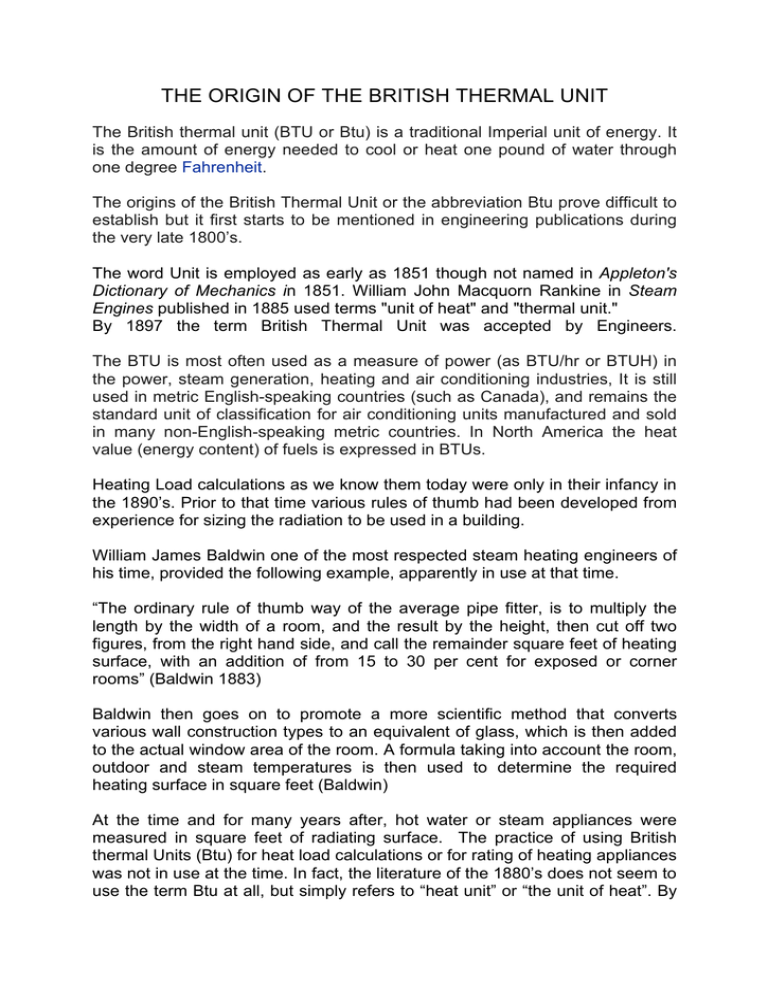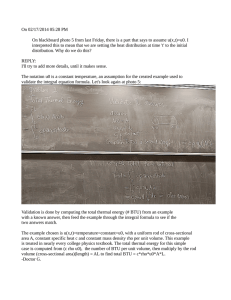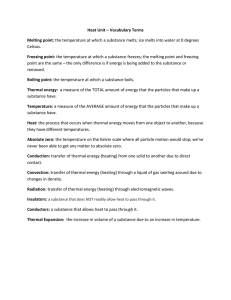Origin of the Btu - CIBSE Heritage Group Website
advertisement

THE ORIGIN OF THE BRITISH THERMAL UNIT The British thermal unit (BTU or Btu) is a traditional Imperial unit of energy. It is the amount of energy needed to cool or heat one pound of water through one degree Fahrenheit. The origins of the British Thermal Unit or the abbreviation Btu prove difficult to establish but it first starts to be mentioned in engineering publications during the very late 1800’s. The word Unit is employed as early as 1851 though not named in Appleton's Dictionary of Mechanics in 1851. William John Macquorn Rankine in Steam Engines published in 1885 used terms "unit of heat" and "thermal unit." By 1897 the term British Thermal Unit was accepted by Engineers. The BTU is most often used as a measure of power (as BTU/hr or BTUH) in the power, steam generation, heating and air conditioning industries, It is still used in metric English-speaking countries (such as Canada), and remains the standard unit of classification for air conditioning units manufactured and sold in many non-English-speaking metric countries. In North America the heat value (energy content) of fuels is expressed in BTUs. Heating Load calculations as we know them today were only in their infancy in the 1890’s. Prior to that time various rules of thumb had been developed from experience for sizing the radiation to be used in a building. William James Baldwin one of the most respected steam heating engineers of his time, provided the following example, apparently in use at that time. “The ordinary rule of thumb way of the average pipe fitter, is to multiply the length by the width of a room, and the result by the height, then cut off two figures, from the right hand side, and call the remainder square feet of heating surface, with an addition of from 15 to 30 per cent for exposed or corner rooms” (Baldwin 1883) Baldwin then goes on to promote a more scientific method that converts various wall construction types to an equivalent of glass, which is then added to the actual window area of the room. A formula taking into account the room, outdoor and steam temperatures is then used to determine the required heating surface in square feet (Baldwin) At the time and for many years after, hot water or steam appliances were measured in square feet of radiating surface. The practice of using British thermal Units (Btu) for heat load calculations or for rating of heating appliances was not in use at the time. In fact, the literature of the 1880’s does not seem to use the term Btu at all, but simply refers to “heat unit” or “the unit of heat”. By the 1900’s the term “heat unit” was still used, but the use of Btu was becoming more common. In 1893 Alfred Wolff introduced heat-unit practice in heating calculations....... 1895 Prof. De Volson Wood, Stevens Institute of Technology, employed "BTU" for British Thermal Units in Thermodynamics written by him and published by John Wiley & Sons, New York, 1893. Quoted reference: The Dictionary of Electrical Words, Terms and Phrases, E J Houston, 1897 (National Bureau of Standards, Washington, DC.) uses "English Heat Unit" in text. In the appendix written for the 1897 edition it uses "British Thermal Unit. The ‘Heating by Hot Water’ Walter Jones book first edition of 1894 does not mention Btu’s, but by the 3rd edition published in 1904 it refers to The Standard Unit of Heat as the British Thermal Unit. So to summarize, the term British Thermal Unit starts to appear in books from around 1897. It then goes into common usage during the first decade of the 1900’s, both in heat loss calculations and for sizing boiler plant and heat emitters. Brian Roberts and Frank Ferris CIBSE Heritage Group




